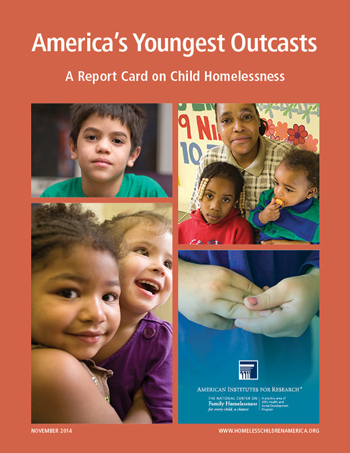Report: 1 in 30 Children Homeless in America
By Cyril Josh Barker New York Amsterdam News | Last updated: Dec 11, 2014 - 8:53:54 AMWhat's your opinion on this article?
NEW YORK (NNPA) - As the nation prepared for the holiday season, new numbers about homeless children revealed that this season may not be so joyous for many.

|
Devastating numbers in a recent report released by the National Center on Family Homelessness at American Institutes for Research reveals that 2.5 million children in the nation are homeless. When broken down, the figure indicates 1 in 30 children experiences homelessness.
The report, titled “America’s Youngest Outcasts,” looks at child homelessness nationally and in the 50 states and the District of Columbia, ranks the states from 1 (best) to 50 (worst), examines causes of child homelessness and suggests solutions. The report will be presented to the U.S. Congress in February 2015.
“Child homelessness has reached epidemic proportions in America,” said Dr. Carmela DeCandia, director of the National Center on Family Homelessness at AIR. “Children are homeless tonight in every city, county and state—in every part of our nation.”
The report uses the newest comprehensive federal and state data, including the annual count of homeless children in public schools made by the U.S. Department of Education.
Progress has been made in reducing homelessness among veterans and chronically homeless individuals because of concerted efforts by the federal government. However, no special attention has been directed toward homeless children, and their numbers have increased.
“Living in shelters, neighbors’ basements, cars, campgrounds and worse, homeless children are the most invisible and neglected individuals in our society,” Dr. DeCandia continued. “Without decisive action now, the federal goal of ending child homelessness by 2020 will soon be out of reach.”
Major causes of child homelessness in the U.S. include the nation’s high poverty rate, a lack of affordable housing across the nation, the continuing impacts of the Great Recession and the ways in which traumatic experiences, especially domestic violence, precede and prolong homelessness for families.
Another factor is racial disparity. One out of every 141 Black family members stayed in a homeless shelter, a rate seven times higher when compared with persons in White families, according to the Institute for Children, Poverty and Homelessness.
Research shows that homeless children are hungry and sick more often than children who are housed.
The impact of homelessness on children, especially young children, may lead to changes in brain architecture that interfere with learning, emotional self-regulation, cognitive skills and social relationships.
Up to 25 percent of homeless preschool children have mental health problems requiring clinical evaluation; this portion increases to 40 percent among homeless school-age children. Many homeless children struggle in school, missing days and repeating grades until they drop out entirely.
In New York City, Black families re-present 55 percent of the shelter population compared with 36 percent of White families in shelters. More than 24,000 homeless children are now sleeping in New York City shelters. In the latest report by the National Center on Family Homelessness at AIR, New York ranks 35th in the nation for homeless children, and New Jersey ranks fifth.
INSIDE STORIES AND REVIEWS
-
-
About Harriett ... and the Negro Hollywood Road Show
By Rabiah Muhammad, Guest Columnist » Full Story -
Skepticism greets Jay-Z, NFL talk of inspiring change
By Bryan 18X Crawford and Richard B. Muhammad The Final Call Newspaper @TheFinalCall » Full Story -
The painful problem of Black girls and suicide
By Charlene Muhammad -National Correspondent- » Full Story -
Exploitation of Innocence - Report: Perceptions, policies hurting Black girls
By Charlene Muhammad -National Correspondent- » Full Story -
Big Ballin: Big ideas fuel a father’s Big Baller Brand and brash business sense
By Bryan Crawford -Contributing Writer- » Full Story






 Click Here Stay Connected!
Click Here Stay Connected!








